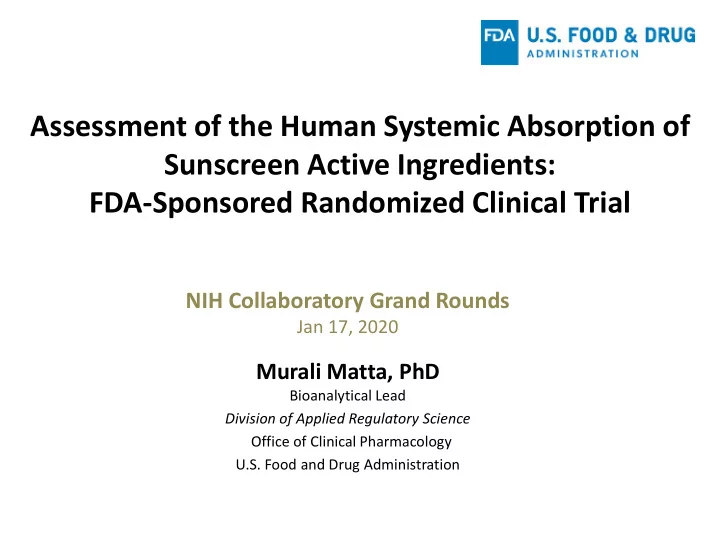

Assessment of the Human Systemic Absorption of Sunscreen Active Ingredients: FDA-Sponsored Randomized Clinical Trial NIH Collaboratory Grand Rounds Jan 17, 2020 Murali Matta, PhD Bioanalytical Lead Division of Applied Regulatory Science Office of Clinical Pharmacology U.S. Food and Drug Administration
Disclaimer This presentation reflects the views of the speaker and should not be construed to represent FDA’s views or policies 2
Overview • Background • Primary Objective • Study Design • Outcomes • Results • Conclusions • Coming Next 3
Background Sunscreens prevent sunburn - reflect or absorb ultraviolet radiation • Sunscreen products applied in substantial amounts multiple times • every day over course of lifetime Active ingredients are organic chemicals, some have been shown to • be absorbed through human skin with detectable levels in the blood or urine • Little known about the systemic exposures, understanding the systemic exposure and its clinical relevance is important • FDA guidance “Nonprescription Sunscreen Drug Products Safety and Effectiveness Data” requests the assessment of the human systemic absorption of sunscreen ingredients with a Maximal Usage Trial (MUsT). • This study is not intended to meet all requirements of MUsT studies, but will follow many of the principles to assess maximal use of a single sunscreen formulation 4
Primary Objective • To explore whether the active components of 4 sunscreen products are absorbed into the systemic circulation when a sunscreen product is applied under maximal-use conditions • Avobenzone • Oxybenzone • Octocrylene • Ecamsule 5
Tested Products Avobenzone 3% Avobenzone 3% Avobenzone 3% Avobenzone 3% Oxybenzone 6% Oxybenzone 5% Oxybenzone 4% Octocrylene 10% Octocrylene 6% Ecamsule 2% Octocrylene 2.35% Octocrylene 10% Homosalate 15% Octisalate 5% 6
Study Design • Subjects: Healthy Volunteers; 18 – 60 years Open-label, randomized 4 group parallel study • Dose: 2 mg/cm 2 75% of body Duration: Every two hours, 4 doses/day; 4 days PK sample: 30 samples pre-dose to 144 h (intensive on days 1 & 4) 7
Outcomes Primary Outcome: • • Maximum plasma concentration (Cmax: day 1 to 7) of Avobenzone Secondary Outcome: • • Maximum plasma concentration of Oxybenzone, Octocrylene and Ecamsule • Exploratory Outcomes: C max on day 1 and 4 • Time at which Cmax occurs on day 1, 4 and overall • AUC on day 1, 4 and overall • • Residual concentrations on each day • Half-life of each ingredient Post-hoc Assessments: • • Number and percentage of participants with plasma concentration exceeding 0.5 ng/mL on day 1 • Drug accumulation from day 1 to 4 8
Statistical Analysis • 24 participants were randomized to receive 1 of the 4 treatments • Randomization was conducted in block sizes of 4 • Not blinded due to differences in formulation types • Data was reported with standard descriptive statistics • Accumulation with repeat dosing was assessed by log-transforming AUC and maximum plasma concentration from day 1 and 4 for each ingredient 9
Demographics Demographics Study (N=24) Age, years (Mean ± SD) 35.5 ± 10.5 Race Black or African 14 (58.3 %) American White 9 (37.5 %) Asian 1 (4.2%) Body mass index, kg/m2 25.0 ± 2.9 (Mean ± SD) Body surface area, m2 1.8 ± 0.2 (Mean ± SD) Fitzpatrick skin type Type 1 0 (0.0 %) Type 2 1 (4.2%) Type 3 5 (20.8%) Type 4 4 (16.7%) Type 5 8 (33.3%) Type 6 6 (25.0%) 10
Systemic Exposure of Avobenzone Matta et al ., JAMA 2019;321(21):2082-2091 11
Systemic Exposure on Day 1 Spray#1: 8h – 100% Spray#2: 8h – 83% Lotion: 8 h – 100% Cream: 8h – 83% Matta et al ., JAMA 2019;321(21):2082-2091 12
Systemic Exposure of Oxybenzone 13 Matta et al ., JAMA 2019;321(21):2082-2091
Systemic Exposure on Day 1 100% of subjects had levels above 0.5ng/mL in 2hrs Matta et al ., JAMA 2019;321(21):2082-2091 14
Systemic Exposure of Octocrylene 2.35% of Octocrylene Matta et al ., JAMA 2019;321(21):2082-2091 15
Systemic Exposure on Day 1 100% of subjects in 6h Except Spray#1 Matta et al ., JAMA 2019;321(21):2082-2091 16
Systemic Exposure of Ecamsule 5 of 6 participants has C max more than 0.5 ng/mL on day 1 Matta et al ., JAMA 2019;321(21):2082-2091 17
C max on Day 1 versus Day 4 18
Residual Concentrations 19
Conclusions • All active ingredients in all tested products exhibited systemic exposures above the threshold for potentially waiving some nonclinical toxicology studies for sunscreens • The systemic exposures supports the need for further studies to determine the clinical significance • These results do not indicate that individuals should refrain from the use of sunscreen 20
Coming Next • A second clinical study was performed to characterize: – Systemic exposure of additional active ingredients – Systemic exposure after a single application – Time to clear from body 21
Study Design of Second Clinical Trial • Subjects: Healthy Volunteers; 18 – 60 years; More subjects Open-label, randomized 4 group parallel study • Dose: 2 mg/cm 2 75% of body Single Application on Day 1 Four applications per day from day 2 to 4 PK samples: 30 samples pre-dose to 480 h (intensive on days 1 & 4) Skin sample: Tape stripping (Day 7 and 14) 22
Acknowledgements Division of Applied Regulatory Science Office of Clinical Pharmacology David Strauss, MD, PhD Dennis Bashaw, PharmD Nageswara Pilli, PhD Issam Zineh, PharmD, MPH Jeffry Florian, PhD Division of Clinical Pharmacology-III Robbert Zusterzeel, MD, PhD, MPH Luke Oh, PhD Vikram Patel, PhD Donna Volpe, PhD Division of Nonprescription Drug Products Division of Pharmaceutical Quality and Research Steven Adah, PhD Yang Yang, PhD Sergio Coelho, PhD Ashraf Muhammad, PhD Theresa Michele, MD Celia Cruz, PhD Spaulding Clinical Research Office of Drug Evaluation IV Sarah Kemp, RN Jian Wang, PhD Anthony Godfrey, PharmD Lesley-Anne Furlong, MD Carlos Sanabria, MD Charles Ganley, MD 23
24
25
Recommend
More recommend